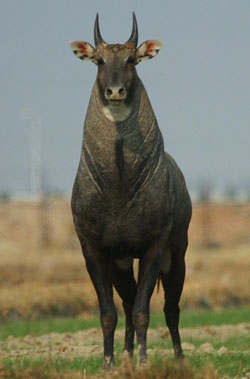
Local name: Nilgai (Urdu)
Description and Biology:
Size:Body Length: 180-200 cm / 6-6.6 ft.
Shoulder Height: 120-150 cm / 4-5 ft.
Tail Length: 40-45 cm / 16-22 in.
Weight: 120-240 kg / 264-528 lb.
Description: The largest of the asian antelope, the nilgai was first described by Pallas in 1766. The short coat is yellow-brown in females, and gradually turns blue-grey in males as they mature. There is an erectable mane on the nape and back and a “hair pennant” in the middle of the underside of the neck. There are white markings in the form of cheek spots, edges of the lips, and a throat bib. Along the underside is a thin white stripe, which “balloons” at the rear. The slender legs support a stocky body, which slopes downwards towards the rear. The head is long and slender. Males have 20-25 cm / 8-10 inch long horns which are straight and tilted slightly forwards.
Reproduction: Weaning: By 10 months. Sexual Maturity: Around 18 months. Life span: Up to 21 years. Gestation Period: About 8 months. Young per Birth: Generally 2 (over 60% of births), sometimes 1 or 3. Breeding occurs throughout the year, but the peak of mating is December-March, with the resulting calves born in September and October.
Social Behavior: The nilgai is mainly diurnal, with peaks in activity in the early morning and late afternoon. The sense of sight is well developed among this wary species. When chased, nilgai can run up to 48 kmph / 29 mph. Males have been observed to establish territories during the breeding season, attempting to gather and keep small herds of females (up to 10) within their area. Males compete with each other with threatening posture displays and neck wrestling, rarely leading to both rivals kneeling and lunging at each other with their horns. Normally silent, nilgai have been recorded making a roaring vocalization. The population density in central India is about 0.07 animals per square kilometer. Single sex or mixed herds of 4-20 individuals, old bulls may be solitary.
Diet: Leaves, buds, grasses, fruit. (all above information from “The Ulimate Ungulate Page” by Brent Huffman).
Habitat and Distribution:
The Nilgai’s preferred habitat is grassy steppe and woodlands area. In Pakistan this Antelope is mainly found in extensive Desert regions, such as Cholistan in Punjab and Thar in Sind. Today the Nilgai is mainly found along the Indo-Pak border in the eastern part of the country. Here they are normaly found solitary. The Nilgai is also found in Changa Manga Plantation near Lahore. Unconfirmed report also come from Azad Kashmir, but the numbers here are thought to be very low. 220 Nilgai were counted in 1999 by the Sind Wildlife Department in the district of Tharparkar.The Nilgai is now rare in the country, but reintroduction programs are in place and it is hoped that these will be released in the wild to secure the few remaining herds.
